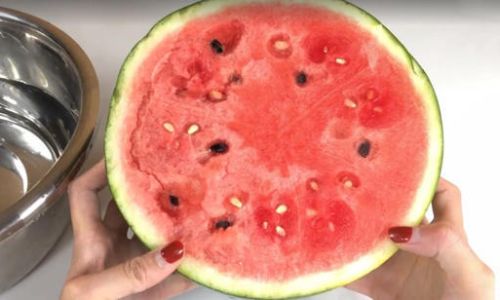Introduction
Watermelon, known for its refreshing taste and high water content, is a favorite summer fruit enjoyed by many. Whether served at barbecues, picnics, or simply enjoyed at home, watermelon provides a delightful way to beat the heat. However, once a watermelon is sliced open, maintaining its freshness can be challenging. Exposure to air, temperature fluctuations, and bacteria can quickly turn a juicy, sweet watermelon into a soggy, unappealing mess. In this comprehensive guide, we will explore various methods and techniques to keep your sliced watermelon fresh, ensuring you can enjoy its deliciousness for longer.
Understanding Watermelon Freshness

Before diving into preservation techniques, it’s crucial to understand what makes watermelon fresh. Freshness in watermelon is primarily determined by its moisture content, sweetness, texture, and the absence of bacteria or mold. Watermelon is composed of over 90% water, making it highly susceptible to dehydration and spoilage if not handled properly. Additionally, its natural sugars can attract bacteria, leading to rapid decomposition.
Immediate Steps After Slicing
-
Clean Tools and Surfaces
- Always use clean knives and cutting boards to slice watermelon. Cross-contamination with other foods can introduce bacteria, accelerating spoilage.
- Wash your hands thoroughly before handling the watermelon to prevent the transfer of dirt and germs.
-
Remove Seeds and Rind
- While seeds are edible and some varieties are seedless, removing them can prevent them from becoming a breeding ground for bacteria.
- The rind, while tough and often discarded, should be removed cleanly to avoid any bitter flavors affecting the flesh.
-
Cut into Appropriate Sizes
Slice or cube the watermelon into portions that are easy to handle and consume. Smaller pieces have a higher surface-to-volume ratio, which can make them more susceptible to dehydration and spoilage, so strike a balance between convenience and preservation.
Storage Methods
There are several effective methods to store sliced watermelon, each with its own set of pros and cons. Here, we explore the most common and effective techniques:
-
Refrigeration
- Covered in the Fridge: The simplest and most common method is to place the sliced watermelon in an airtight container or cover it with plastic wrap and store it in the refrigerator. The cold temperature slows down bacterial growth and preserves the watermelon’s moisture.
- Pro Tip: Avoid stacking heavy items on top of the container, as this can compress the watermelon and ruin its texture.
- On a Plate with Wet Paper Towel: Another method is to place the slices on a plate lined with a damp paper towel. Cover the plate loosely with plastic wrap, ensuring there’s some airflow to prevent condensation from building up and making the watermelon soggy.
- Pro Tip: Replace the wet paper towel daily to keep it from drying out and becoming a source of bacteria.
- Covered in the Fridge: The simplest and most common method is to place the sliced watermelon in an airtight container or cover it with plastic wrap and store it in the refrigerator. The cold temperature slows down bacterial growth and preserves the watermelon’s moisture.
-
Freezing

- For longer-term storage, freezing watermelon is an option. However, it will change the texture, making it more suitable for smoothies, sorbets, or icy treats rather than fresh eating.
- Puree Method: Blend sliced watermelon into a puree, pour into freezer-safe containers, and freeze. Once solid, you can transfer the blocks to a freezer bag to save space.
- Cubes Method: Cut the watermelon into small cubes, place them on a baking sheet lined with parchment paper, and freeze until solid. Transfer the frozen cubes to a freezer bag.
- Pro Tip: Label the containers or bags with the date to keep track of how long the watermelon has been frozen.
-
Pickling and Preserving
- While less common for watermelon, pickling can extend its shelf life and add a unique flavor profile. This involves submerging watermelon slices in a vinegar-based brine, which acts as a preservative.
- Sugar Syrup Method: Another preservation technique is to soak watermelon slices in a simple syrup and then store them in an airtight container in the refrigerator. This method adds sweetness and helps maintain moisture but doesn’t significantly extend shelf life beyond a few days.
Maintaining Optimal Conditions
Regardless of the storage method chosen, maintaining optimal conditions is crucial for preserving watermelon freshness:
-
Temperature Control
- Refrigerate watermelon at a temperature between 35°F and 40°F (2°C and 4°C). This range slows bacterial growth and preserves texture and flavor.
- Avoid storing watermelon in the crisper drawer if it’s too humid, as this can cause condensation and promote mold growth.
-
Humidity Management
- Keep the storage environment slightly humid to prevent dehydration. However, excessive humidity can lead to mold, so find a balance.
- Using damp paper towels or cloths can help manage humidity in small, enclosed spaces like refrigerator shelves.
-
Air Exposure
- Limit air exposure as much as possible. Air can cause dehydration and oxidation, leading to discoloration and loss of moisture.
- Use airtight containers or tightly seal plastic wrap to create a barrier between the watermelon and the air.
Monitoring and Consumption
Regularly check stored watermelon for signs of spoilage:
-
Visual Inspection
- Look for discoloration, mold, or slimy textures. Fresh watermelon should have a vibrant color and firm texture.
- Discard any slices that show signs of spoilage to prevent contamination of the remaining fruit.
-
Smell Test

Fresh watermelon has a sweet, slightly earthy aroma. If it smells sour, musty, or has an off-putting odor, it’s best to discard it.
-
Taste Test
Before serving, taste a small piece to ensure it still tastes sweet and refreshing. If it tastes bland or off, it’s a sign that the watermelon is losing its freshness.
Creative Uses for Leftover Watermelon
To minimize waste and maximize enjoyment, consider creative uses for leftover watermelon:
-
Watermelon Juice
Blend leftover slices to make refreshing watermelon juice. Add a touch of lime or mint for extra flavor.
-
Watermelon Sorbet
Freeze leftover puree to make a delicious, homemade sorbet. It’s a perfect treat on a hot day.
-
Watermelon Salad

Combine leftover watermelon cubes with feta cheese, cucumber, and a light vinaigrette for a refreshing summer salad.
-
Watermelon Granita
Make a granita by freezing watermelon puree in a shallow dish and scraping it with a fork to create a flaky texture.
-
Watermelon Gazpacho
Blend leftover watermelon with tomatoes, cucumbers, onions, and herbs for a unique and refreshing gazpacho soup.
Conclusion
Keeping sliced watermelon fresh requires a combination of proper handling, storage, and regular monitoring. By understanding the factors that affect freshness and implementing effective preservation techniques, you can enjoy watermelon’s sweet, juicy taste for longer. Whether you choose to refrigerate, freeze, or find creative culinary uses, these methods will help you make the most of your summer watermelon harvest. Remember, the key to success is to act quickly after slicing, store under optimal conditions, and regularly check for signs of spoilage. With these tips in mind, you’ll be able to savor the deliciousness of watermelon throughout the warm summer months.






0 comments